

XDomainRequest Object. Represents a cross-domain Asynchronous JavaScript and XML (AJAX) request.
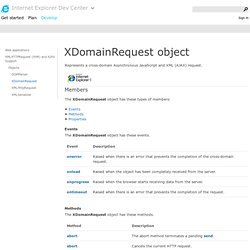
Members. HTTP/1.1. HTTP/1.1: Method Definitions. XMLHttpRequest: Latest Editor Version. Abstract The XMLHttpRequest specification defines an API that provides scripted client functionality for transferring data between a client and a server.
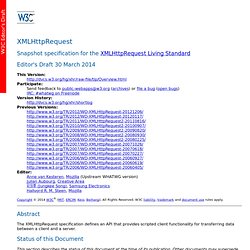
Status of this Document This section describes the status of this document at the time of its publication. Other documents may supersede this document. A list of current W3C publications and the latest revision of this technical report can be found in the W3C technical reports index at. Abort() and Mozilla bug. Page last changed today In my continuing quest to understand XMLHTTP I gathered some very intriguing material that I'm quite sure will save somebody else's ass.
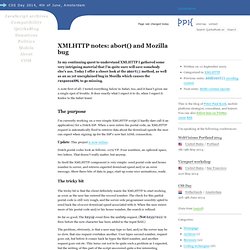
Today I offer a closer look at the abort() method, as well as an as yet unexplained bug in Mozilla which causes the responseXML to go missing. A note first of all: I tested everything below in Safari, too, and it hasn't given me a single spot of trouble. XMLHTTP notes: <code>readyState</code> and the events. XMLHTTP notes: cloning nodes, inserting forms, and caching. Page last changed today In the past two weeks I've again created an Ajax-driven interface, and as usual I discovered quite a few interesting XMLHTTP bugs and problems.
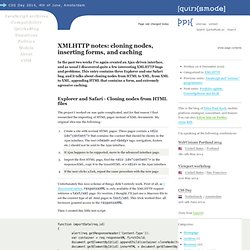
This entry contains three Explorer and one Safari bug, and it talks about cloning nodes from HTML to XML, from XML to XML, appending HTML that contains a form, and extremely agressive caching. The project I worked on was quite complicated, and for that reason I first researched the importing of HTML pages instead of XML documents. My original idea was the following: Create a site with normal HTML pages. A Detailed Explanation of the XMLHttpRequest Object. Synchronous JavaScript and XML (AJAX ) is a term for the process of transferring data between a client script and the server.
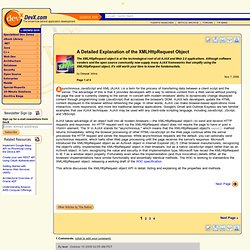
The advantage of this is that it provides developers with a way to retrieve content from a Web server without posting the page the user is currently viewing to the server. In concert with modern browsers' ability to dynamically change displayed content through programming code (JavaScript) that accesses the browser's DOM, AJAX lets developers update the HTML content displayed in the browser without refreshing the page.
In other words, AJAX can make browser-based applications more interactive, more responsive, and more like traditional desktop applications. Google's Gmail and Outlook Express are two familiar examples that use AJAX techniques. AJAX may be used with any client-side scripting language, including JavaScript, JScript, and VBScript. This article discusses the XMLHttpRequest object API in detail, listing and explaining all the properties and methods. All about XMLHttpRequest (in Russian) Ajax Reference (XMLHttpRequest object) Created: July 22nd, 2008 Ajax is a popular term used to describe asynchronous (versus synchronous) requests made from the client to the server.

In JavaScript, Ajax requests are handled using the XMLHttpRequest object, which lets you open a connection, send the request, then handle the data returned by the server seamlessly in the background. Related Tutorials XMLHttpRequest Constructor All Ajax requests in JavaScript begin by making a call to the XMLHttpRequest constructor function: new XMLHttpRequest() //IE7, Firefox, Safari etc In IE6 and below, the XMLHttpRequest() is not supported, but instead relies on the proprietary ActiveXObject for Ajax requests. //Usage:new ajaxRequest() Once equalized, the returned HTTP request instance shares the same properties and methods across browsers, thankfully. Note: Any examples below use the custom HTTP request function above as their foundation.
Properties Event handler Methods Note: "[]" surrounding a parameter below means the parameter is optional. Receiving binary data in older browsers. XMLHttpRequest makes sending HTTP requests very easy.
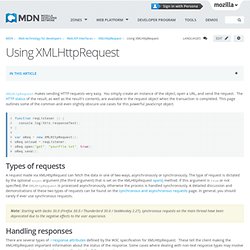
You simply create an instance of the object, open a URL, and send the request. The HTTP status of the result, as well as the result's contents, are available in the request object when the transaction is completed. Downloading Binary Streams with Javascript XMLHttpRequest. (or How to do Binary Ajax) I've been fiddling around trying to download a binary stream using the object XmlHttpRequest (XHR) of Javascript in Mozilla Firefox.
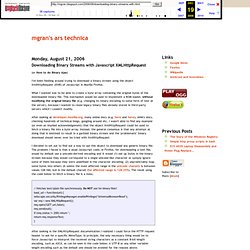
What I wanted was to be able to create a byte array containing the original bytes of the downloaded binary file. This mechanism would be used to implement a ROM loader, without modifying the original binary file (e.g. changing its binary encoding to some form of text at the server), because I wanted to reuse legacy binary files already stored in third-party servers which I couldn't modify. After looking at developer.mozilla.org, many online docs (e.g. here and here), IANA's docs, checking hundreds of technical blogs, googling around etc, I wasn't able to find any example (or even an implied acknowledgement) that the object XmlHttpRequest could be used to fetch a binary file into a byte array. I decided to set out to find out a way to use this object to download any generic binary file.
//fetches text/plain file synchronously. Re-inventing XMLHttpRequest: Cross-browser implementation with sniffing capabilities. IE 7 - Native xmlHttpRequest Not So Good. When I found out IE7 was going to implement a native javascript object, xmlHttpRequest, in addition to their own Microsoft.XMLHTTP object, I was thrilled.

This meant once IE 6 was phased out of the world, all my ajax stuff wouldn’t need to check browser before proceeding. For the most I use ajax frameworks ( that already have this built in but I do write my own xmlhttp request on occasion. For an internal application I have an ajax search functionality built that queries a database and returns customers names on key entry. List of Microsoft XML Parser (MSXML) versions. This article lists the version numbers of Microsoft XML Core Services or the Microsoft XML parser (MSXML).

Different versions of MSXML are included with various Microsoft products, such as Microsoft Windows, Microsoft Internet Explorer, Microsoft Office, and Microsoft SQL Server. MSXML is also updated when you install software updates for various Microsoft products. Error Messages. Error values whose names begin with "ERROR_WINHTTP_" are specific to the WinHTTP functions. The WinHTTP functions also return Windows error messages where appropriate.
An error occurred executing the script code in the Proxy Auto-Configuration (PAC) file. Returned if connection to the server failed. Windows Server 2003 with SP1 and Windows XP with SP2: This error is not supported. The application does not have the required privileges to access the private key associated with the client certificate. What version will be chosen by MSXML2.XMLHTTP request, without version suffix? Using the right version of MSXML in Internet Explorer - Microsoft XML Team's WebLog. The code iterates through the "progIDs" array and instantiates the highest version MSXML DOM that is available on the machine and returns it to the caller (see below for details on which versions ship where). This has at least a few implications: My goal for this post is to give a quick history of MSXML lifecycle and versions, provide details with an example on implementing best practices with MSXML on the web, and talk about a couple key things to watch out for.
If you want the full story please read on, but if you’re short on time and want the quick scoop here it is in 4 bullets: Use MSXML 6.0 - it is “in the box” on and available for download on Win2k, XP, and 2003. XMLHttpRequest.js at master from ilinsky/xmlhttprequest - GitHub. XMLHttpRequest Level 2: Latest Editor's Draft. New Tricks in XMLHttpRequest2. Introduction One of the unsung heros in the HTML5 universe is XMLHttpRequest. Strictly speaking XHR2 isn't HTML5. However, it's part of the incremental improvements browser vendors are making to the core platform. I'm including XHR2 in our new bag of goodies because it plays such an integral part in today's complex web apps. Turns out our old friend got a huge makeover but many folks are unaware of its new features.
This tutorial highlights some of the new features in XMLHttpRequest, especially those that can be used for working with files. Fetching data. Ajax file upload with pure JavaScript. Warning! Outdated article. Update The API I wrote about in this article has been removed from recent versions of Firefox. Instead, you can now use a FileReader object to read files on the client, and a FormData object to serialize such file values and POST them using asynchronous requests. These two objects are also available in Chrome and Safari, possible other browsers too.